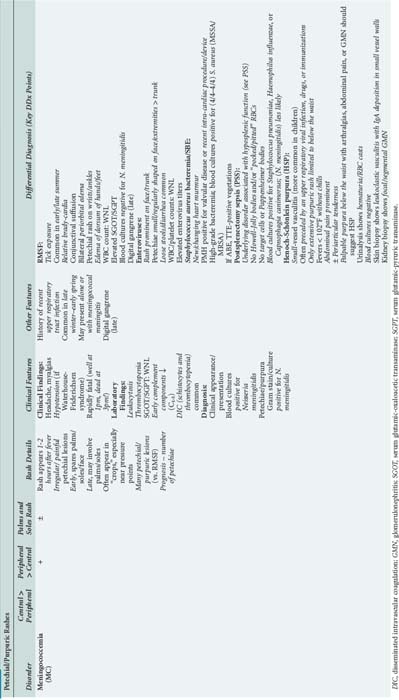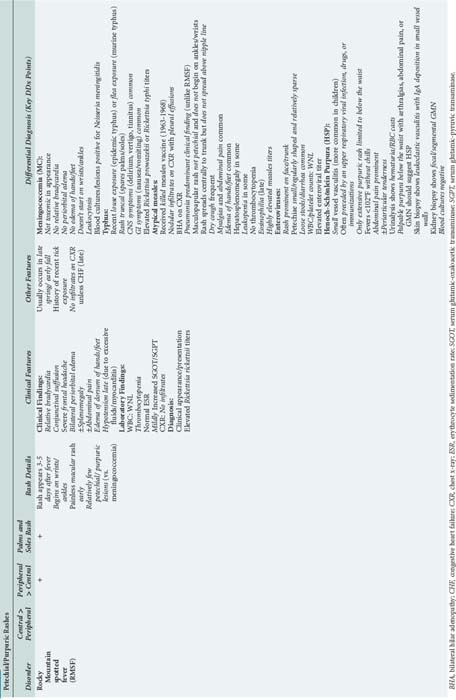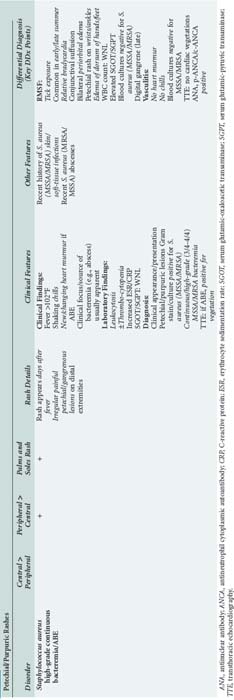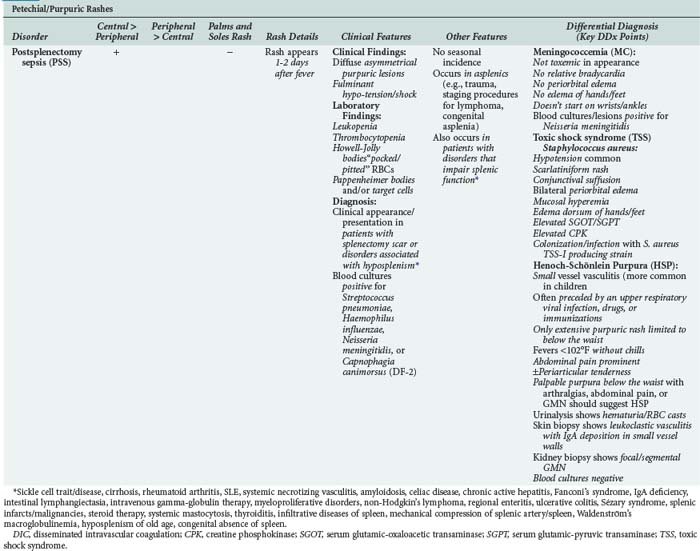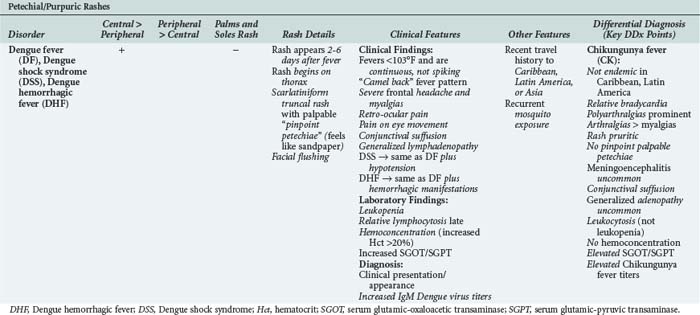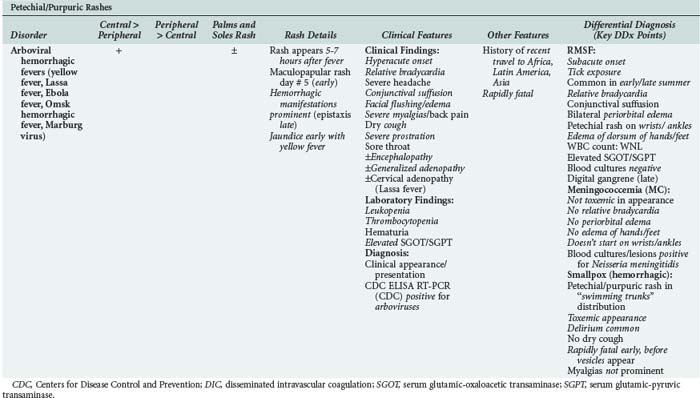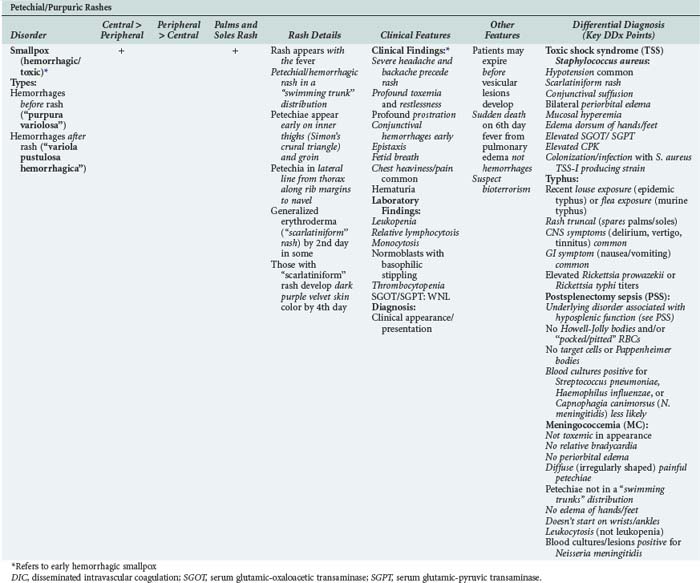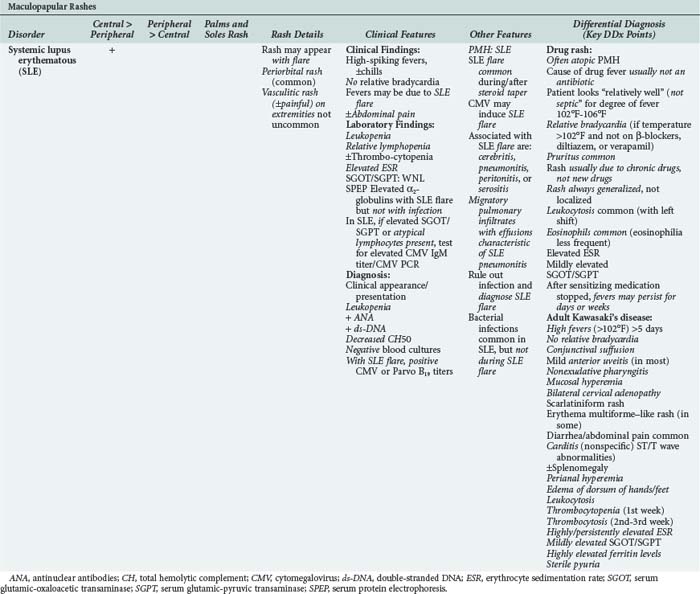26 Rashes and Fever
 Clinical Approach
Clinical Approach
The clinical diagnostic approach to rash and fever in the intensive care unit (ICU) depends on whether the rash and fever were community or nosocomially acquired. Community-acquired rash and fever is best approached by considering the distribution/characteristics of the rash.1–5 Rashes are visible clues to infectious or noninfectious disorders. In addition to rash and fever, often associated findings such as history, physical examination, and laboratory abnormalities are keys to the correct diagnosis.1,4,6–8
Nosocomially acquired rashes have more limited differential diagnostic possibilities.6 The clinician should determine whether the rash and fever represents the primary clinical problem or is a superimposed finding unrelated to another process—for example, ICU patients admitted for acute myocardial infarction can develop a drug rash from an antiarrhythmic medication, beta-blocker, diuretic, or sulfa-containing stool softener (Colace).1,3
Acutely ill patients with rash and fever in the ICU should have the benefit of an infectious disease consultation by an experienced infectious disease clinician.1,3 Both community and nosocomial acquired rash/fever are best diagnosed using the clinical syndromic approach; associated clinical findings, not the appearance of the rash per se, are the main determinants of arriving at the correct diagnosis.5,7
Community-Acquired Rash and Fever
Patients admitted to the ICU from the community with rash/fever are best approached by the type/distribution of the rash.2 The degree of fever relative to the pulse rate, and fever pattern are also important diagnostic considerations.3,9
Petechial/Purpuric Rashes and Fever
While petechial/purpuric rashes are common causes of community-acquired rash/fever, petechiae can accompany a variety of systemic infections as well as a variety of noninfectious disorders.10–12 Rash/fever are often potentially life-threatening (e.g., meningococcemia [MC] with or without meningitis, Rocky Mountain spotted fever [RMSF], dengue fever [DF], and arboviral hemorrhagic fevers), and patients should have the benefit of a diagnostic evaluation by an experienced infectious disease consultant.1,4,10,11
The two most common infectious diseases presenting with a petechial/purpuric rash are MC and RMSF. RMSF should be suspected with a recent tick exposure history and/or a characteristic location/distribution of the rash. Importantly, RMSF is the only infectious exanthem that begins on the wrists and/or ankles.13–15 In contrast, the rash of MC is asymmetrical with irregularly shaped painful petechial/purpuric lesions.1,8,11
Post-splenectomy sepsis (PSS) can resemble meningococcemia but only occurs in patients with impaired/absent splenic function.1,4,11 Clinicians should be familiar with the disorders associated with diminished splenic function. A key clinical clue to impaired splenic function is the presence of Howell-Jolly bodies or “pocked/pitted” red blood cells in the peripheral smear. The number of Howell-Jolly bodies or “pocked/pitted” RBCs is inversely proportional to splenic function.1,8
High-grade/continuous Staphylococcus aureus bacteremias (methicillin sensitive/methicillin resistant [MSSA/MRSA]) from abscesses or acute bacterial endocarditis (ABE) are often accompanied by splinter hemorrhages and petechial/purpuric rashes on the distal extremities.1,10,11
Maculopapular Rashes and Fever
The most common maculopapular rashes/fever associated with serious systemic diseases are toxic shock syndrome (TSS) and systemic lupus erythematosus (SLE). SLE flares can mimic infectious diseases.1,4,11 Thus, SLE pneumonitis can mimic community-acquired pneumonia (CAP), and SLE cerebritis can mimic acute bacterial meningitis (ABM). Laboratory studies can differentiate an SLE flare in the absence of infection from an SLE flare with infection. Typically, SLE flares without infection are accompanied by leukopenia, decreased complement levels, and elevated α1/α2 globulins on serum protein electrophoresis (SPEP).1,8
TSS can occur in any patient colonized/infected with a TSS-1-producing strain of S. aureus. TSS may not come to mind when there are no overt signs of clinical infection (e.g., staphylococcal colonization of the nares). TSS also may be due to group A streptococci or Clostridium sordelli.2,4,11
Vesicular/Bullous Rashes and Fever
Vesicular eruptions limit the diagnostic possibilities to chickenpox or herpes zoster (shingles) due to varicella zoster virus (VZV). Herpes zoster may be localized (dermatomal) or disseminated.5–7 Before the appearance of the vesicular rash/fever, dermatomal herpes zoster, depending on dermatomal distribution, can be a difficult diagnostic problem, mimicking many disorders.6 Herpes zoster involving the head and/or neck may be associated with VZV meningitis/encephalitis. Disseminated shingles can resemble chickenpox, but patients with herpes zoster have a prior history of chickenpox.1,4,11
Community-acquired bullous lesions in the ICU may be due to S. aureus soft-tissue infection, Vibrio vulnificus, or gas gangrene (clostridial myonecrosis). Except when due to S. aureus, all the causes of bullae/fever are painful and tense and accompanied by diarrhea. Clostridial myonecrosis, (i.e., gas gangrene) may be present after a crush injury or trauma. The commonest cause of bullae/fever is S. aureus cellulitis/pyoderma.10–12
The differential diagnostic features of community-acquired rash/fever are presented in tabular form in Tables 26-1 to 26-16.1–19
< div class='tao-gold-member'>

Full access? Get Clinical Tree


